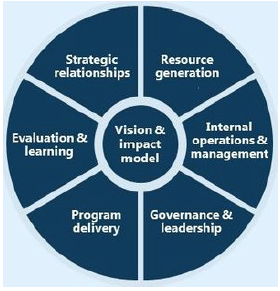Congratulations! You have made a decision to engage the services of an Interim Executive Director (Interim ED/CEO) during your organization’s leadership transition.Transitions are powerful opportunities to strengthen nonprofit organizations. Properly managed and supported with expert executive transition services, they can serve as “pivotal moments” enabling organizations to change direction, maintain momentum, build or rebuild its infrastructure, and clarify its mission and vision. Poorly managed executive transitions incur high costs to organizations and communities.
I have prepared this document as a guideline for what you can expect during my tenure.
The Evelyn and Walter Haas, Jr. Fund and the Annie E. Casey Foundation have made substantial investments in developing the field of practice associated with executive transition management. This has continued through the Alliance for Nonprofit Management. Research has identified the use of Interim Executive Directors/CEOs as a powerful capacity-building strategy for Nonprofits who want to turn their leadership transition into a time for gaining a deeper understanding of organizational improvement and learning, leading to sustained mission results.
My goal as an Interim ED is to be as clear and supportive as possible with the Board of Directors and staff in order to achieve a sustainable leadership succession that is strategic and aligns with the overall mission.
The Interim ED manages the day to day operations of the organization and supports the Board of Directors in carrying out the nonprofit’s business. Given the interim role and tenure is more limited than the Executive Director, not all responsibilities are carried out with equal attention, but each is equally important. Together with the Board and staff, we establish top priorities. Duties often encompass:
- Financial management
- Fundraising/Resource Development
- Boardfunctioning/governance
- Staffing structure/infrastructure/staff development
- Program operations/contract management
- Culture and communications
- Strategic plan/business plan/business model
- Major events and organization calendar
- Executive Director search and onboarding (assist the Board if needed)
- Specific goals and workplan for 6-12 month transition period
Key Transition Actions for First Two - Eight Weeks of the Interim Executive Director Tenure
The first several weeks is a critical time for clarification and communication with the Board, management/leadership team, and staff in order to insure alignment with the Interim ED roles and responsibilities. Primary tasks include:
- Meet with the Board members responsible for the transition to gain their perspective on the current status of the organization and to orient them on how best to utilize an Interim ED. As requested, speak to other key stakeholders and staff in order to collect data on organization standing.
- Review all internal documents (proposals, reports, Board minutes, contracts, evaluations) to gain a thorough grounding of process, procedures, history and current status.
- Gain understanding of the following:
- Timing and reason for ED departure
- Organizational dynamics (staff culture and morale, board operations)
- Strength of Leadership Team
- Financial health
- Fundraising status: on target? expectations for year?
- Major events during Interim ED tenure: gala, proposals, reports, audit?
- Core capacity building needs to address (see chart below)
- Top priorities, deliverables and deadlines
- Interview the departing ED for perspective and priorities. Gain the calendar for the year.
- Stabilize the organization, acknowledging the unique nature of the transition time.
- Develop a work schedule and open door policy.
- Acknowledge and monitor loss/grief and change concerns. Help staff with transition.
- Get to know Leadership Team and gain understanding of their work priorities and concerns.
- Visit all program sites and observe programs in action.
- Review all key financial documents.
- Develop a work plan with performance goals and objectives based on discovery findings.
- Gain a deep working knowledge of all of the below capacity areas:
Ongoing Transition Actions During the Interim Executive Director Tenure
- Work closely with staff and review performance goals and expectations.
- Meet regularly with Leadership Team to build a cohesive and accountable team.
- Carry out all programmatic needs.
- Keep Board on track, provide regular monthly reporting.
- Relationship building with stakeholders/donors/funders with periodic updates.
- Continue to work with staff and Board to envision the future and how they want things to be different (or similar) under new leadership.
- Continuously review Interim ED workplan and performance goals to insure relevancy.
- Serve as a consultant for search committee/search consultant as requested.
Ongoing Communications Provided by Your Interim Executive Director
Communication is the name of the game during a transition. It is important to clarify the type of communications expected from your Interim ED. Here are some samples of written and in-person communications I provide:
- Interim ED Discovery Report of Findings at first or second Board meeting based on initial internal review and discovery meetings.
- A custom workplan with performance goals and top priorities.
- Monthly report to the Board of Directors via the Board packet and through other email updates.
- Weekly check-in with Board chair; monthly Board meeting; other committee meetings throughout the month (typically finance, development and governance).
- Bi-Weekly check-in with staff Leadership team; weekly supervision of direct reports; monthly all-staff meetings.
- Final Report and closing recommendations and items to be handed off to new ED.
Important Underlying Principles of Organizational Transitions
(Adapted from the work of William Bridges)
When there is a shift in executive leadership, organizations experience many new and often unexpected challenges. Transition research has shown that awareness and understanding of the transition process can benefit all staff and Board members in maintaining a positive outlook about these changes. It can also better prepare the organization for its next phase of leadership. In addition, a new Executive Director entering an organization will have an easier time adjusting and being successful if the organization has done this preparation and has high levels of optimism about the future.
Some important concepts about transitions:
√ Change is the objective event: loss of Executive Director; new Executive Director is hired.
√ Transition is the psychological process of reorientation as a result of the change(s).
√ Transitions must be well managed or change becomes unmanageable.
√ Transitions include three overlapping phases consisting of:
- An Ending Phase – gaining closure on the executive’s departure;
- A Middle Phase or the Neutral Zone - a time of organizational vulnerability, and importantly, of heightened opportunity; and
- A New Beginning Phase – includes the new executive’s welcome and onboarding, partnered with significant organizational changes and new ways of doing business.
As an Interim Executive Director, I maintain awareness of these principles throughout my placement. I watch for behaviors and actions that might be the result of anxiety often associated with change and I work with staff to alleviate and normalize concerns. I also embrace the positive aspects of change, focusing on staff and organizational strengths and preparing for the new Executive Director.
I am never a candidate for the Executive Director position as a means for establishing an objective and open perspective on organizational life and health often revealed during a leadership change.
Let’s Get Started!



